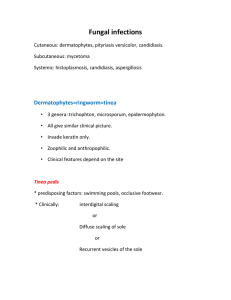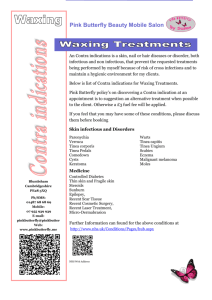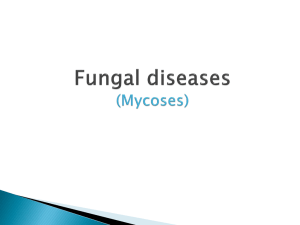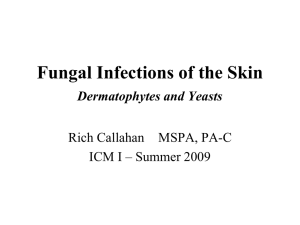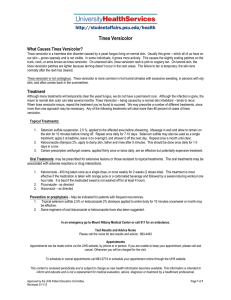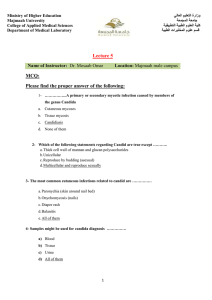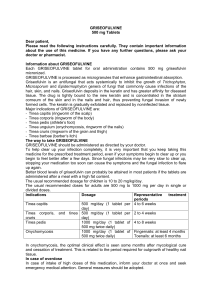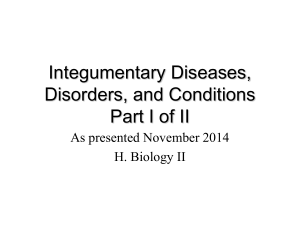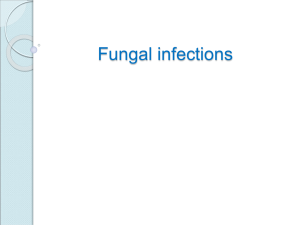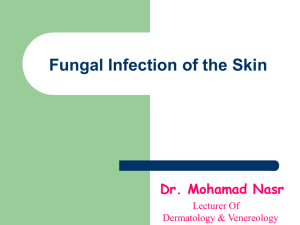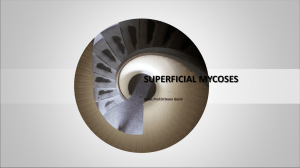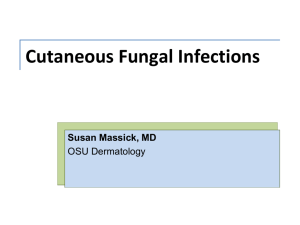Lecture 19- Mycology Atlas
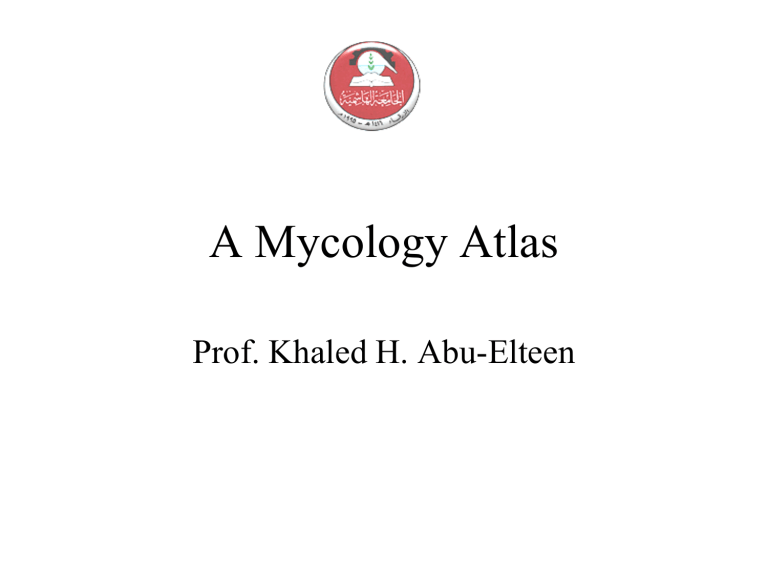
A Mycology Atlas
Prof. Khaled H. Abu-Elteen
Cryptococcosis, face. This patient had cryptococcal meningitis with cutaneous lesions. Note the unusual ulcerations. Patient was severely immunocompromised with HIV disease .
Histoplasmosis, face. There are numerous erythematous plaques on the skin of this patient who had disseminated histoplasmosis spread from his lungs. This individual was
HIV positive.
Tinea barbae upper lip. This represents an unusual presentation of a fungal infection involving the skin. Note the scaly plaque just underneath the nostrils and above the lip.
Tinea corporis , eyelid. The eyelid is an unusual site for a fungal infection. Note the erythematous scaly plaques.
Tinea capitis. Here is a severe, persistent form of a tinea infection involving the scalp and resulting in considerable loss of hair. The hypopigmentation is due to the inflammation associated with this chronic infection.
Candidiasis, scallp. This case represents a subcutaneous and cutaneous form of candidiasis with loss of hair.
Candidiasis, tongue (Thrush). The condition is characterized by white thick mucoid plaques which adhere to the tongue and mucosal surfaces, but can be easily scraped off for examination
Candidiasis, tongue. This condition may be one of the earliest signs of underlying immunodeficiency in a patient with HIV infection. A KOH smear of the scrapings reveals the characteristic hyphae of the yeast organism
Tinea corporis, arm. This picture shows the classic appearance of what is commonly called "ringworm".
Erythematous circinate plaques with scaly margins are typical.
Tinea versicolor, neck and upper back. This chronic infection has resulted in the loss of pigmentation in the infected areas. Lesions become more evident as patients go in the sun.
Versicolor, shoulder. There is involvement of the supraclavicular region in this young female patient. These lesions tend to recur periodically once an individual has acquired this fungal infection.
Tinea corporis, neck. Here one sees scaly, slightly hyperpigmented plaques in a linear distribution.
Tinea corporis, axilla. Fungal infections in the axillary region are often scaly and itchy, and become ulcerated due to maceration.
Candidiasis, thigh. Note the marked erythematous plaques and the satellite papular lesions at the peripheral margins of the larger infected areas
Candidiasis, thigh. Close-up.
Onychomycosis, toenails. Note the thinning and friable nature of the nails.
Onychomycosis, toes with tinea pedis
Tinea pedis, foot. The redness and scaling typically seen with this condition extend over the toe web onto the toes.
Candidiasis, toenails. Marked thickening and discoloration, along with deformity of the toenail, are commonly seen in this condition.
Candidiasis, web of fingers. Candida infections of the skin are often associated with cracking, scaliness and erythema
Candida albicans, culture on Sabouraud dextrose agar. Note the white color and smooth texture. Candida albicans is the yeast most frequently isolated from human infections.
Candida albicans., direct microscopic examination of skin scrapings (KOH mount). Note the hyphae with buds and individual yeast cells, many with buds. The original magnification was about 400x. (Compare with the KOH mount of the dermatophytes.)
Trichophyton rubrum, culture on Sabouraud dextrose agar. Note the white, wooly texture of this dermatophyte. It also produces a red or red-brown pigment on the undersurface.
Direct microscopic examination of dermatophytes in skin scrapings (KOH mount). Note the thread-like filaments which break into chains of spores (arthroconidia) in certain areas.
Malassezia furfur, skin scraping. This was taken from a patient with tinea versicolor. Note the short hyphae and clusters of thickwalled cells.
Malassezia furfur does not grow on Sabouraud dextrose agar.
Cryptococcus neoformans, skin biopsy. Note the presence of yeast cells surrounded by a clear halo. This clear zone represents the space occupied by the thick capsule formed by the organism in tissue.
Histoplasma capsulatum, cell cytoplasm. About eight of these tiny yeasts can be seen in the cytoplasm.
Blastomyces dermatitidis, tissue. Note the round yeasts with only a single bud.
